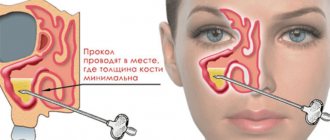Fetal hypoxia is a dangerous pathological process characterized by reduced oxygen supply to the fetus.
Hypoxia occurs due to atypical processes occurring in the female body. The time of formation, course and intensity of symptoms directly affect the development and general health of the child. Treatment of hypoxia must be carried out as early as possible so that the disease does not cause irreparable consequences.
Hypoxia can be diagnosed at any stage of pregnancy. The sooner intrauterine fetal hypoxia occurs, the more seriously it will affect the development of the child (both mental and physical). It can also cause damage to the central nervous system, but this is in case of untimely or improper treatment. Medical statistics show that oxygen deficiency occurs in 10-15% of all pregnancies. Treatment in this case is primarily aimed at normalizing blood flow to the uterus and placenta, but in case of acute fetal hypoxia, it is recommended to induce labor artificially rather than using any treatment methods.
Intrauterine fetal hypoxia
The causes of intrauterine fetal hypoxia are various pathologies occurring in the maternal body, as well as unfavorable environmental factors. Hypoxia can occur due to diseases:
- hypertension
- diabetes
- heart disease
- preeclampsia and eclampsia
- chronic bronchitis or bronchial asthma
- various kidney diseases
Intrauterine causes of hypoxia:
- damage to the integrity of the uterus
- prolonged compression of the child’s head and neck during childbirth
- complication of the baby’s passage through the birth canal, most often due to large volumes or incorrect position of the baby
- increase in amniotic fluid volume
- pregnancy with two, three or more fetuses
- intrauterine infection of a child
- obstruction of the birth canal from the uterus by the placenta
- wrapping the umbilical cord around the baby's neck
- disruption of blood flow in the placenta
In addition, external factors :
- poor ecology and high air pollution in the place where the expectant mother lives
- taking a large number of medications
- chemical poisoning
- abuse of alcohol, nicotine or drugs by a woman during pregnancy
Deadly pregnancy complication: who is at risk
Monitoring the course of pregnancy is 50% highly artistic pasting tests into a card, and 50% - performing completely routine procedures: weighing, measuring the abdomen with a centimeter tape, examining the limbs and measuring blood pressure (BP). On two hands. Necessarily. From an early date.
Once upon a time, the USSR managed to significantly reduce maternal mortality rates in a simple but surprisingly effective way.
A midwife was stationed in every small settlement who could measure a pregnant woman’s blood pressure and independently boil a portion of urine in order to find protein in it.
Simple midwives in the USSR and highly educated obstetrician-gynecologists in modern Russia are doing the same thing - persistently looking for signs of impending preeclampsia - a formidable and deadly complication of pregnancy.
What is preeclampsia?
This is a serious complication of pregnancy, in which the functioning of the entire body is seriously disrupted. In addition to the increase in blood pressure, a large amount of protein appears in the urine, the number of platelets in the blood decreases, the functioning of the liver and kidneys suffers, epigastric pain, visual disturbances, and severe headaches appear.
The condition can rapidly progress and lead to convulsions with loss of consciousness - eclampsia.
Preeclampsia begins after 20 weeks of pregnancy. The sooner, the more dangerous. Preeclampsia that develops before 32 weeks of pregnancy is considered early; pregnancy always ends prematurely, because attempts to preserve it can kill both mother and child.
Sometimes preeclampsia develops in the postpartum period, which is why obstetrician-gynecologists never relax.
Why is this happening?
Science still cannot give an exact answer to this question, despite the fact that the pathogenesis of the disease is well studied.
In some cases we can predict the development of the disease, but almost never we can prevent it.
At risk:
- primigravida;
- women who had preeclampsia in a previous pregnancy;
- preeclampsia in relatives (mother, sister);
- women who suffered from arterial hypertension before pregnancy or experienced an increase in blood pressure for the first time before 20 weeks;
- women with a history of kidney disease;
- women with diabetes mellitus, autoimmune diseases (systemic lupus erythematosus, scleroderma, antiphospholipid syndrome), thrombophilic conditions;
- obese women;
- women aged 40+ (another hello to all fans of the idea of delayed motherhood);
- multiple pregnancies;
- pregnancy after IVF
What is the child's risk?
Preeclampsia may require emergency delivery at any stage of pregnancy. This is often the only way to save the mother's life.
Severe prematurity in a newborn is a heavy burden that can affect the rest of a person’s life. Despite the breakthrough successes of modern neonatology, which has made it possible to nurse 500-gram babies, the mortality rate among premature babies is very high.
What does a woman risk?
Women who experience preeclampsia are likely to experience the condition in each of their pregnancies, with subsequent preeclampsia always more severe than the previous one.
Despite the fact that preeclampsia goes away with pregnancy, the risks of developing cardiovascular diseases, hypertension, stroke and heart attack remain.
Without adequate help, you may develop eclampsia, a severe seizure disorder similar to epilepsy. Acute renal failure, pulmonary edema are rapidly increasing, stroke or myocardial infarction, placental abruption, sudden intrauterine fetal death, retinal detachment with loss of vision can occur.
What is HELLP syndrome?
HELLP syndrome was first described in 1954. This is an abbreviation made up of the first letters: hemolysis - intravascular destruction of red blood cells (Hemolysis), increased activity of liver enzymes (Elevated Liver enzymes) and thrombocytopenia (Low Platelet Count).
This serious and potentially fatal condition is accompanied by severe blood clotting disorders, necrosis and rupture of the liver, and cerebral hemorrhages.
Dangerous symptoms
You should immediately consult a doctor if swelling appears on the face and hands, headaches that do not go away after taking conventional medications, blurred vision - blurred vision, “veil and fog”, flashing “spots” before the eyes.
Preeclampsia can manifest itself as pain in the epigastric region, right hypochondrium; nausea and vomiting in the second half of pregnancy, difficulty breathing are dangerous. A sudden weight gain (3-5 kg per week) may be a warning sign.
Preeclampsia is not mild
The most difficult thing for an obstetrician-gynecologist is not to panic ahead of time. Sometimes the situation allows you to delay time a little to allow the fetal lungs to ripen.
Up to 34 weeks, corticosteroids are administered to prevent respiratory distress syndrome. Sometimes the situation quickly worsens and requires immediate action and delivery.
How to prevent preeclampsia?
Unfortunately, doctors can predict many obstetric complications, but cannot prevent them. Over the years of research, a long list of disappointments has accumulated. The bed-rest regimen (resting in a lying position during the day), limiting table salt, fish oil or taking garlic tablets will definitely not help prevent the development of preeclampsia.
Neither taking progesterone medications, nor using magnesium sulfate, nor taking folic acid, nor using heparins, including low molecular weight ones (Clexane, Fraxiparin) is not a preventive measure. However, all of these drugs can be used during pregnancy for other purposes.
If the risk of preeclampsia is high, your doctor may suggest taking acetylsalicylic acid daily after the 12th week of pregnancy.
Pregnant women with low calcium intake (<600 mg per day) are advised to take supplemental calcium in the form of medications.
The best thing you can do is take care of prevention before pregnancy. Hypertension should be well controlled before conception.
Obesity requires weight loss, diabetes requires compensation and reliable control. Unfortunately, this is the right but difficult path.
Most often, women come into pregnancy with a whole bunch of problems that require urgent solutions.
Obstetricians and gynecologists around the world continue to measure blood pressure. On two hands. On every visit. And they ask you not to forget to regularly take a general urine test. This is a life-saving strategy.
Oksana Bogdashevskaya
Photo depositphotos.com
The opinion of the author may not coincide with the opinion of the editors
Degrees of fetal hypoxia
Based on the rate of progression, hypoxia is divided into:
- short-term, i.e. occurs quickly and unexpectedly
- moderate severity – expressed directly during childbirth
- acute – signs of the disease are observed several days before the upcoming birth
- chronic fetal hypoxia - it appears with severe toxicosis, incompatibility of blood groups or Rh factors of the mother and child, intrauterine infections of the fetus.
according to the time of occurrence :
- formed in the first months of pregnancy
- in the second half of the allotted time
- during childbirth
- occurs very rarely after childbirth.
Symptoms of fetal hypoxia
Hypoxia is quite difficult to determine, since it can appear suddenly. But it is very important to diagnose hypoxia in the early stages, because this will allow you to quickly begin treatment and avoid consequences.
The main symptom of fetal hypoxia is a slow heartbeat , but this cannot be noticed at home. The first sign to consult a doctor is a change in the intensity of fetal kicks . Every woman feels movement, but if the child makes itself felt less than three times a day, you should immediately contact a specialist, because this indicates chronic intrauterine fetal hypoxia.
The acute form, which occurs suddenly, is characterized by completely opposite signs - the child is too active, pushing hard.
Signs of fetal hypoxia in the first three months of pregnancy are very difficult to determine, so it would be better for the woman and the fetus to be examined by a doctor weekly.
Consequences of fetal hypoxia
If you ignore symptoms or contact a doctor late, hypoxia seriously threatens the health and development of the fetus.
Complications of chronic fetal hypoxia can include:
- disorders of the development and formation of internal organs, bones and brain of the fetus
- intracellular edema
- internal hemorrhages
- delayed fetal development
For a newborn child, the consequences are no less serious:
- changes in the structure and structure of some internal organs; hemorrhages
- inability to independently perform functions characteristic of the first days after birth
- neurological diseases
- mental retardation
- psychical deviations
- Cerebral palsy and autism
Acute and chronic fetal hypoxia can lead to fetal death in the womb or death of the child during the first week of life.
What is hypoxia, forms of pathology
Hypoxia is intrauterine growth retardation due to lack of oxygen. At a short period of time, the pathology provokes a stop in the growth of the embryo, and at a later stage, the formed organs and life support systems cannot function at full capacity.
Pathology can develop at any stage of pregnancy. Complications depend on the form and nature of the disease.
Hypoxia is classified into threatening and incipient. The first form is not dangerous and can be prevented, but the second requires urgent treatment. There are also two forms of the disease: chronic and acute.
How to determine fetal hypoxia
Determining fetal hypoxia starting from the fifth month of pregnancy is not difficult. It is much more difficult to do this in the first 3 months, but the earlier the diagnosis is made, the higher the likelihood of avoiding the consequences of the disease.
Diagnosis of fetal hypoxia consists of:
- Using special gynecological diagnostic techniques, the transparency, color and amount of amniotic fluid is assessed
- Doppler ultrasound, which allows you to track the speed of blood flow in the umbilical cord and placenta
- Ultrasound
- CTG
- listening to heart rate through a stethoscope
- monitoring the intensity of fetal movements
Treatment of fetal hypoxia
At the first manifestation of symptoms of fetal hypoxia, a pregnant woman is immediately hospitalized. The first thing treatment is aimed at is stabilizing the oxygen supply to the fetus and reducing the tone of the uterus. To do this, the patient is prescribed strict bed rest and medications that will improve oxygen permeability and metabolism. Oxygen therapy and hyperbaric oxygenation (pressure chamber) are also often prescribed, which increases blood oxygenation not only in the mother’s body, but also in the fetus.
When the first improvements in the condition of the fetus are observed, the woman can perform gymnastics, various breathing exercises, and attend aqua gymnastics. If no measures to normalize the supply of oxygen to the fetus have had the desired effect or symptoms of fetal hypoxia persist for more than twenty-eight weeks of pregnancy, it is best to immediately perform a cesarean section. In case of acute hypoxia, a newborn child requires the help of a resuscitator.
Causes of hypoxia in newborns
Hypoxia in the fetus, that is, chronic oxygen starvation, occurs in women with certain diseases or due to the characteristics of pregnancy. These reasons include:
- Diabetes;
- Infection of the body with viruses, especially in the first trimester of pregnancy;
- The threat of miscarriage is prolonged or frequently repeated;
- Multiple pregnancy;
- Low water;
- Anemia in a woman;
- Partial placental abruption;
- Impaired blood supply to the placenta;
- Harmful addictions - drinking alcoholic beverages, drug addiction, smoking.
Acute lack of oxygen is a consequence of complications that arise during labor. Most often this is:
- Wrapping the baby in the umbilical cord and compressing it;
- Polyhydramnios;
- Prolonged labor when delivering twins or triplets;
- Premature placental abruption. This condition often occurs with unjustified puncture of the amniotic sac, rapid labor, and active stimulation of labor with medications;
- Weakness of generic forces.
If there are signs of increasing hypoxia in the fetus, an emergency cesarean section may be required.
Prevention of fetal hypoxia
Prevention of fetal hypoxia should be carried out by a woman who has decided to become a mother, namely:
- choose the right way to give birth to a child. A caesarean section is less likely to cause fetal hypoxia than a natural birth.
- timely treatment of diseases that accompany pregnancy
- avoid strong physical exertion, only breathing exercises
- get enough rest
- rationalize your diet by consuming plenty of vitamins and calcium
- lead a healthy lifestyle, give up alcohol, nicotine and drugs
- be regularly observed at the antenatal clinic
- register with an obstetrician-gynecologist on time
- plan pregnancy and carefully prepare for it, through examination by doctors, treatment of chronic, infectious or gynecological diseases
There are many studies related to the treatment of fetal hypoxia. One of them is the use of barotherapy in the treatment of fetal hypoxia.
Chronic form
Chronic hypoxia is a pathology that occurs over a long period of time. Most often, this is the result of a late visit to the doctor or ignoring medical procedures. A woman in an interesting position should be regularly observed by a gynecologist, have a fetal ultrasound done upon request and undergo screening examinations.
Prolonged lack of oxygen causes a lot of complications. In the early stages, the process of formation of organs and life support systems is disrupted in the fetus, anomalies incompatible with life often develop, and the pregnancy ends in spontaneous miscarriage. If the fetus survives, then the performance of the brain, nervous system and other organs is distorted. Because of this, malnutrition often occurs, this is a developmental delay due to a lack of vitamins and nutrients.
At later stages, chronic hypoxia contributes to the slow growth of the child and at the same time provokes the development of other complications, internal organs cannot function and fully develop, problems with blood flow, and necrotic lesions are possible.
Unfortunately, most pathologies cannot be treated and the child is forced to live with them. Often with this diagnosis, premature birth occurs, and the baby is underweight.










